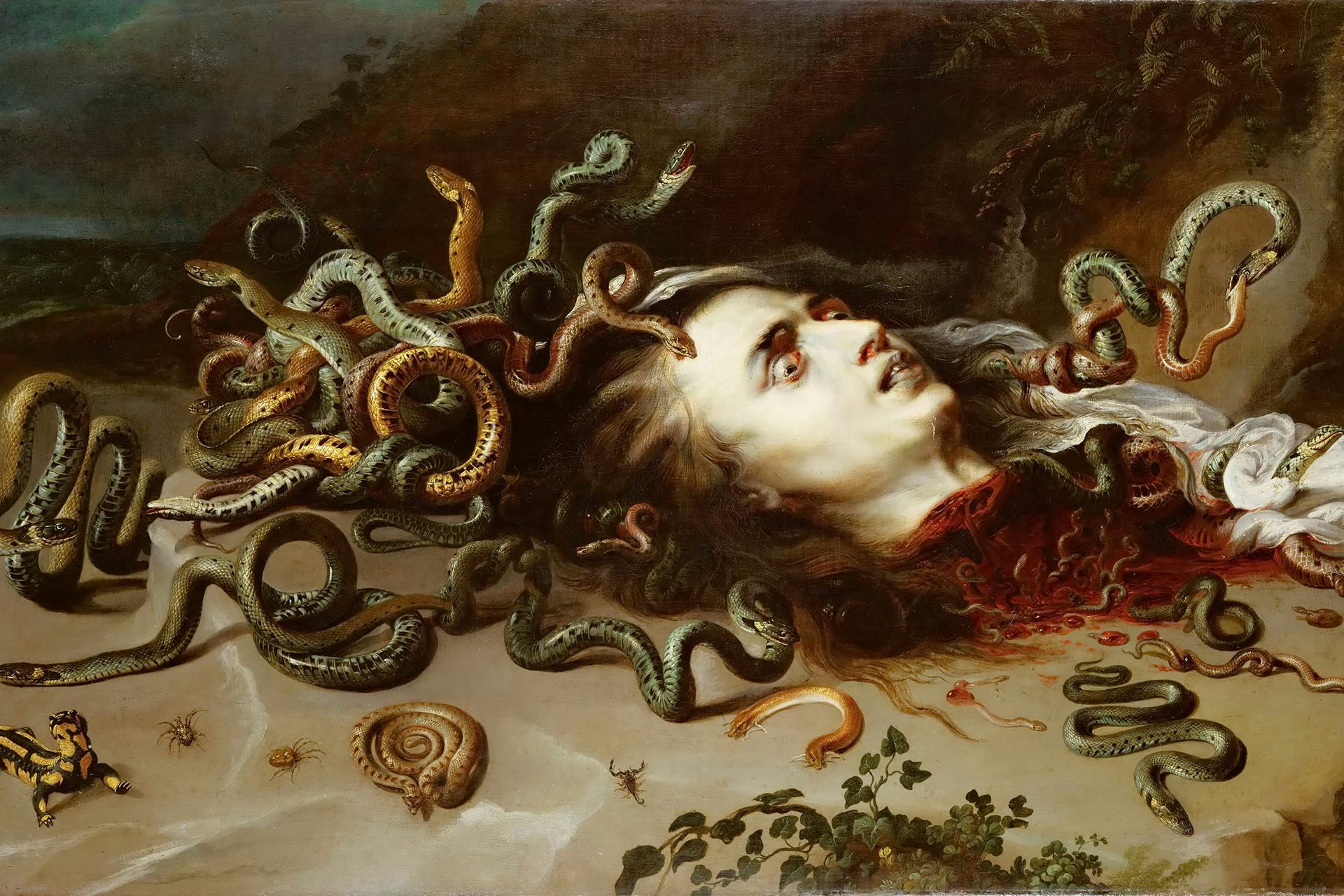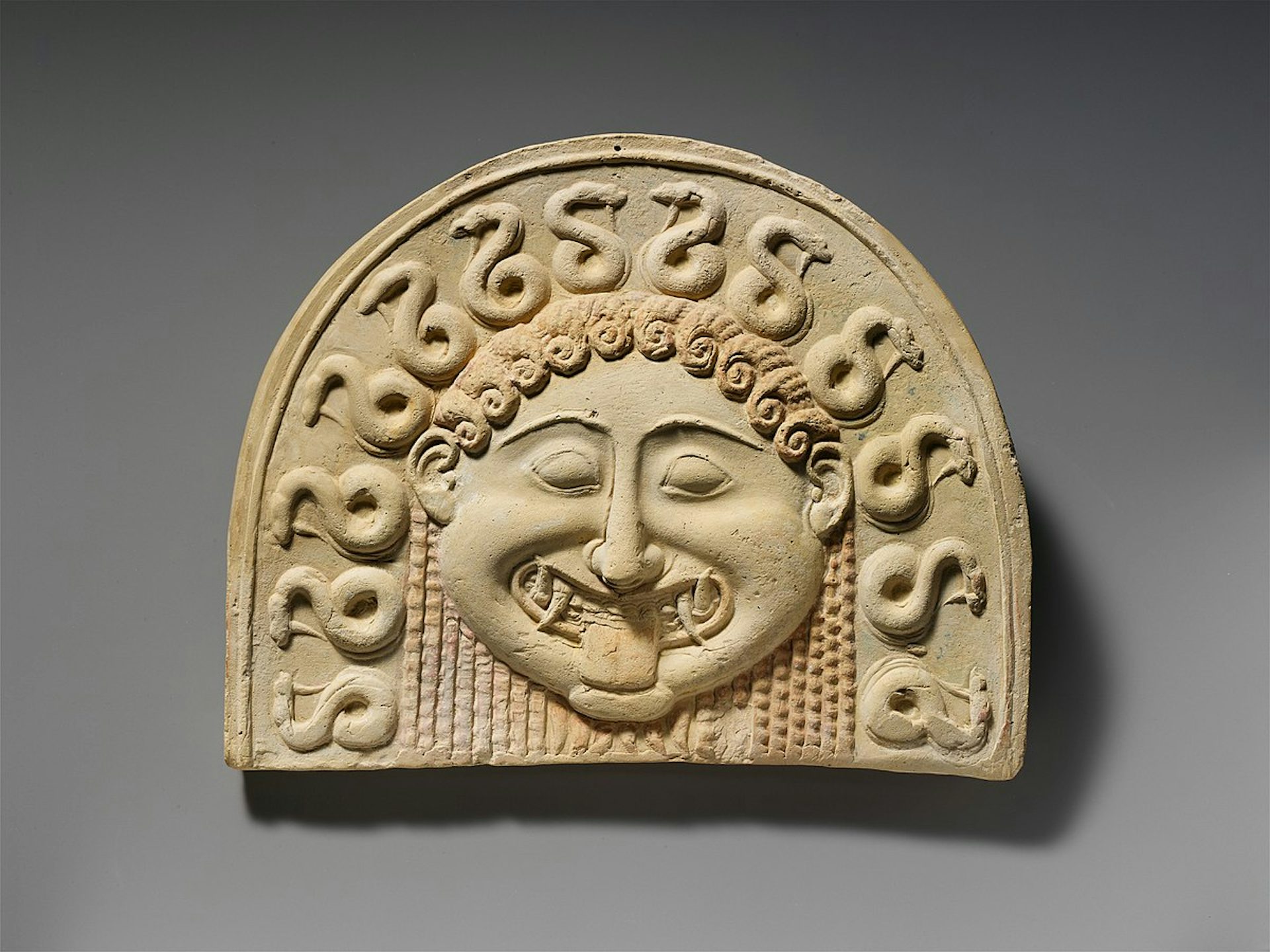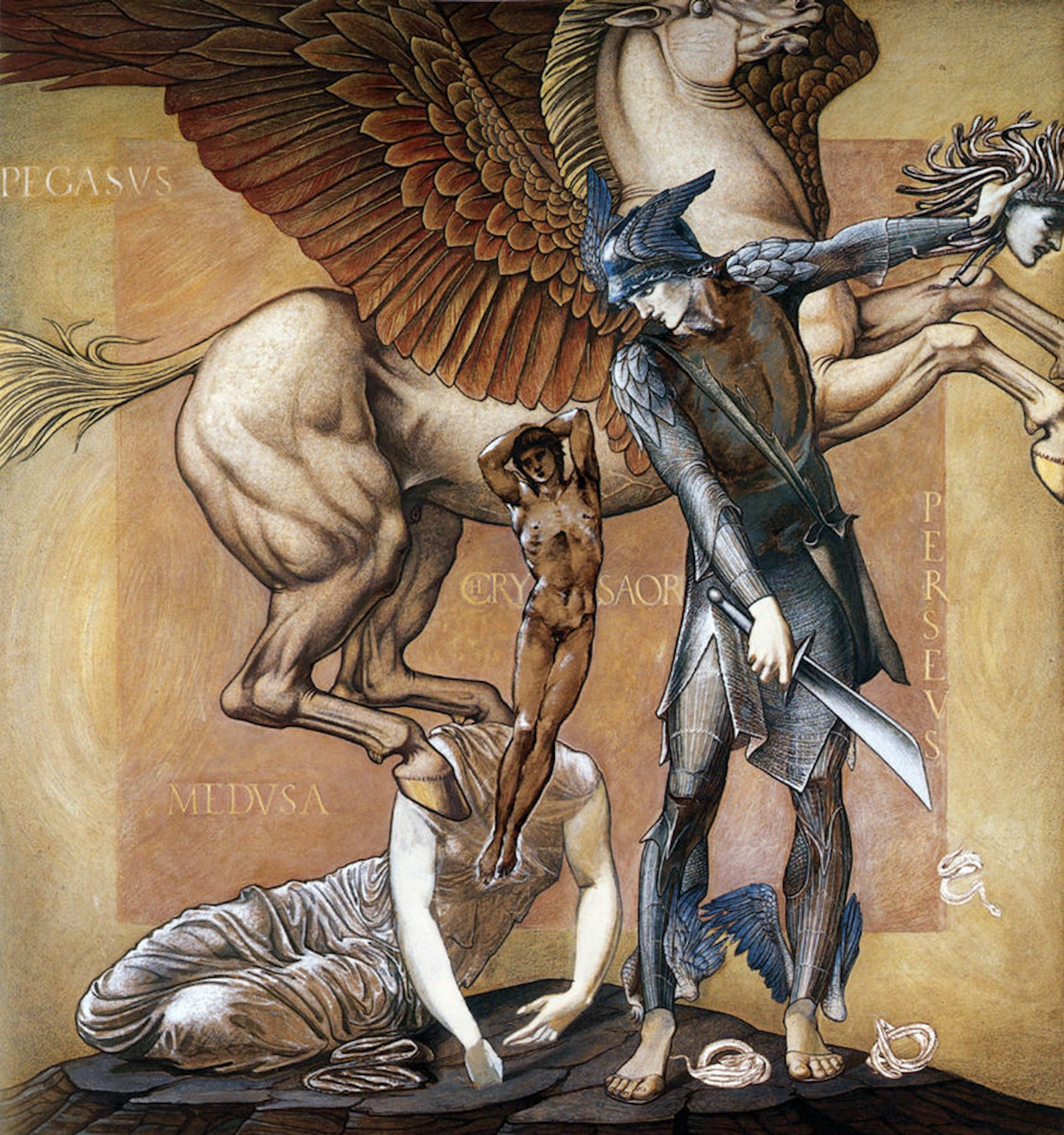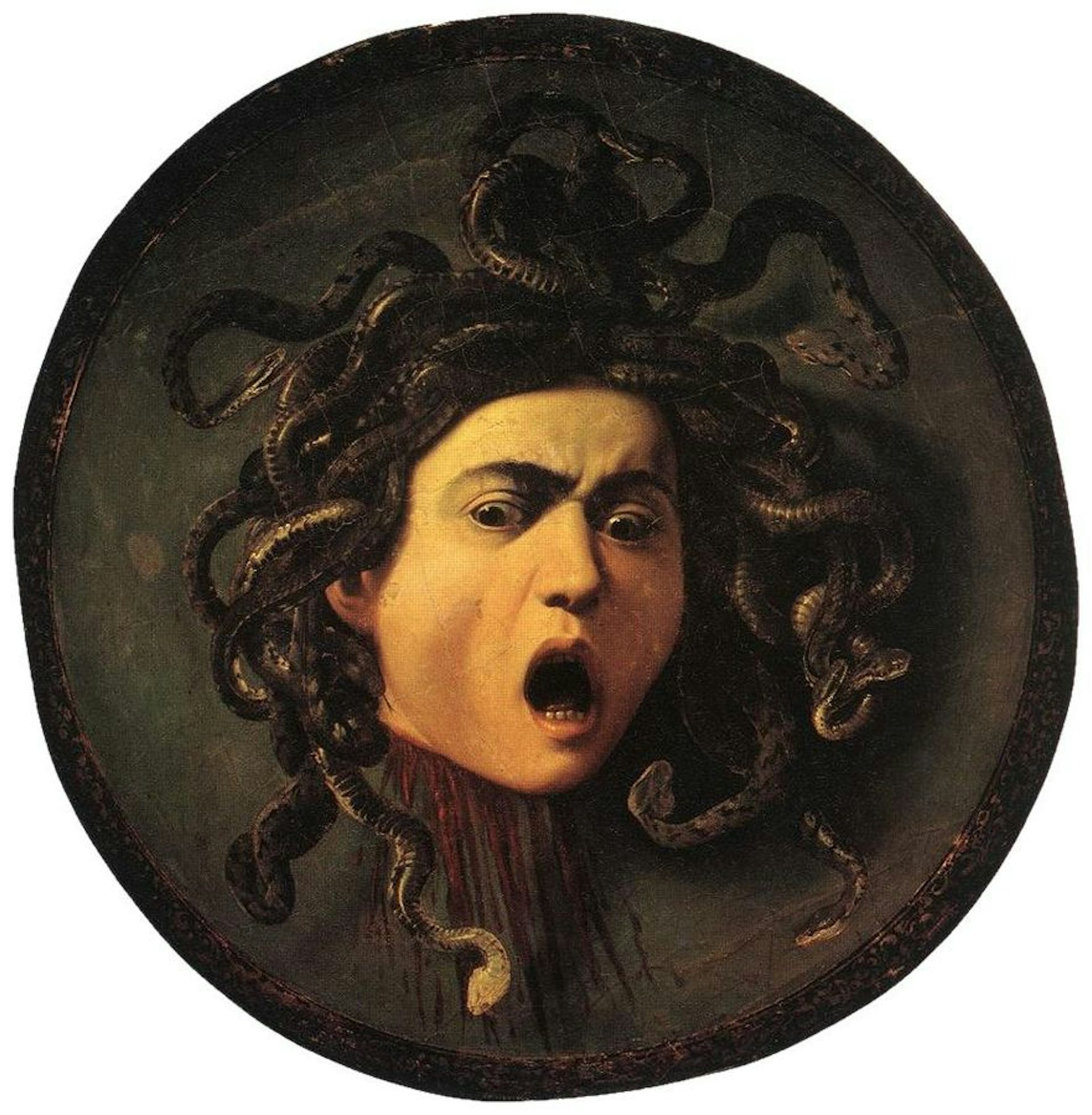Medusa

Overview
Medusa, the daughter of the sea gods Phorcys and Ceto, was the most feared of the Gorgons. It was said that anyone who looked directly at her was immediately turned to stone. Medusa was often depicted as a terrifying winged female with snakes instead of hair.
Many later versions of the myth claimed that she was once a beautiful maiden loved by Poseidon. But the young Medusa offended Athena and was therefore cursed to be a terrible monster, forever hunted by men.
Medusa was eventually killed by Perseus, one of Zeus’ heroic sons. With the help of several gods, Perseus tracked Medusa down to her remote lair and beheaded her. He then used her severed head as a weapon during his travels, turning his enemies to stone. Medusa’s head was finally given to the goddess Athena, becoming part of the armor she wore into battle.
Etymology
The name Medusa was likely derived from the Greek verb medein (“to guard, protect”). This root also appears in other Greek names, including Medea, Medon, and Diomedes.
Pronunciation
English
Greek
Medusa Μέδουσα Phonetic
IPA
[muh-DOO-zuh, -suh] /mɪˈdjuːzə, -sə/
Alternate Names
Medusa was sometimes called Gorgo.
Titles and Epithets
In one of his poems, Pindar applied the epithet euparaos (“fair-cheeked”) to Medusa.[1]
Attributes
Locale
Medusa and her sisters were called the Gorgons. They lived together in a remote part of the world. According to the seventh-century BCE poet Hesiod, they could be found “beyond glorious Ocean in the frontier land towards Night.”[2] Later sources, however, usually placed them in Libya.[3] Other authors have proposed still more remote dwelling places, including the obscure Gorgonean Plains near Cisthene in Asia Minor[4] and the island of Sarpedon.[5]
Appearance
In most ancient sources, Medusa and the Gorgons were imbued with a terrifying appearance. Aeschylus, for example, in his fifth-century BCE tragedy Prometheus Bound, described them as “three winged sisters, the snake-haired Gorgons, loathed of mankind, whom no one of mortal kind shall look upon and still draw breath.”[6] It was said that anybody who looked upon Medusa (or her sisters) was immediately turned to stone.
According to many sources, however, Medusa was beautiful as well as terrifying. Pindar, an early Greek poet who lived in the fifth century BCE, described Medusa as “fair-cheeked.”[7]
Iconography
In ancient art, Medusa was originally depicted as a hideous monster. In addition to being snake-haired and winged, she was often pictured with fangs and a wide, menacing face. Depictions of this Gorgon head were often believed to be “apotropaic,” meaning they could ward off evil. By the fifth century BCE, however, Medusa and the Gorgons were increasingly depicted as beautiful women in the visual arts as in literature.[8]

Gorgon head on terracotta tile, South Italy (c. 540 BC).
Wikimedia CommonsPublic DomainFamily
Family Tree
Mythology
Origins
Medusa was one of the three Gorgons, daughters of the sea gods Phorcys and Ceto. The other two Gorgons were named Stheno and Euryale. Medusa was the only one of the three who was not immortal.
Medusa was said to have once been a lover of Poseidon. According to Ovid, this is what first got her into trouble: when Medusa slept with Poseidon in a temple of Athena, Athena turned her hair into snakes as a punishment. From then on, all who looked upon her were turned to stone.[15] In another version of the myth, Medusa became the enemy of Athena because she claimed that she could rival the goddess in beauty.[16]
Perseus
Medusa was killed by the hero Perseus, a son of Zeus and the mortal Argive princess Danae. Perseus had been sent to fetch Medusa’s head by Polydectes, a cruel king who wished to have Perseus out of the way so he could marry his mother, Danae. Perseus was assisted by the gods, who provided him with a mirrored shield, winged sandals, a helmet of invisibility, an adamantine sword, and a magical satchel that could carry Medusa’s head.
When Perseus found the Gorgons, he used the helmet of invisibility to sneak up on Medusa. He then used the mirrored shield to kill her, looking at Medusa’s reflection rather than directly at her so that he would not be turned to stone. After Perseus had beheaded Medusa and put her head into his satchel, he used his winged sandals to quickly fly away from the other two vengeful Gorgons.[17]
Offspring
After Medusa was killed, her two children by Poseidon were born from her blood. One was the Giant Chrysaor, who became the father of the monster Geryon. Much later, Geryon was killed by Heracles. Medusa’s other child was Pegasus, the beautiful winged horse. Pegasus was eventually tamed by the hero Bellerophon.[18]

The Death of Medusa I by Edward Burne-Jones (1882).
Wikimedia CommonsPublic DomainThe venomous vipers of the Sahara were also sometimes said to have been born from Medusa’s blood. In this myth, the vipers emerged from the droplets of Medusa’s blood as Perseus flew over the Sahara with the Gorgon’s severed head.[19]
According to Ovid, the corals of the Red Sea were formed when Perseus set Medusa’s head down in the seaweed after saving Andromeda. Medusa’s blood caused the seaweed to harden and become beautiful coral.[20]
Medusa’s Head
After killing Medusa, Perseus used her severed head as a weapon, turning many of his enemies to stone. In Libya, he used Medusa’s head to kill the monster Cetus and save Andromeda, who became his wife. When Andromeda’s former fiancé Phineus attacked him, Perseus killed him, too, using Medusa’s head. Upon returning to Seriphos, Perseus showed the king Polydectes the head and turned him to stone, thus saving his mother.
In some traditions, Perseus also met Atlas, the Titan charged with holding up the heavens, during his travels. The two quarreled and Perseus angrily forced Atlas to look upon Medusa’s head. Atlas immediately turned to stone, thus becoming the Atlas Mountains.[21]
Perseus eventually gave Medusa’s head to Athena, who placed it on her breastplate or shield, called the aegis. According to another tradition, however, the head was kept in the city of Athens, buried underneath a mound in the agora.[22]

Medusa by Michelangelo Caravaggio (1595–96).
Wikimedia CommonsPublic DomainThe serpentine locks of Medusa’s hair had an effect very similar to that of the head: while they did not necessarily turn people to stone, they could scatter entire armies. One such lock was sometimes said to protect the Greek city of Tegea.[23]
Medusa’s blood was sometimes thought to have magical or medicinal properties. According to Apollodorus, Asclepius received a phial of her blood from Athena and used it to cure the sick.[24] Medusa’s blood was also used for witchcraft by some mythical figures.[25]
Other Interpretations
Not all ancient sources interpreted the myth of Medusa literally. According to Athenaeus, a Greek author who lived during the late second and early third centuries CE, the Gorgons were long-haired beasts, so terrifying that all who looked upon them were paralyzed and killed.[26]
Other authors believed the Gorgons were an ancient race of wild, hairy women.[27] The antiquarian Diodorus of Sicily claimed that they were wiped out by Heracles when he traveled through Libya.[28]
Pop Culture
Medusa has made several appearances in modern pop culture. She was portrayed using stop motion animation in the 1981 film Clash of the Titans. She also appeared in the 2010 remake as a monster with a serpentine lower body. The BBC One series Atlantis (2013–2015) features Medusa before she became a monster.
Medusa is also a character in the first installment of Rick Riordan’s Percy Jackson and the Olympians series and is portrayed by Uma Thurman in the 2010 film adaptation.
Medusa or her Gorgon sisters appear in many video games and role-playing games, including Dungeons and Dragons, God of War, and Final Fantasy.
The head of Medusa is used as the logo of the Italian fashion company Versace.